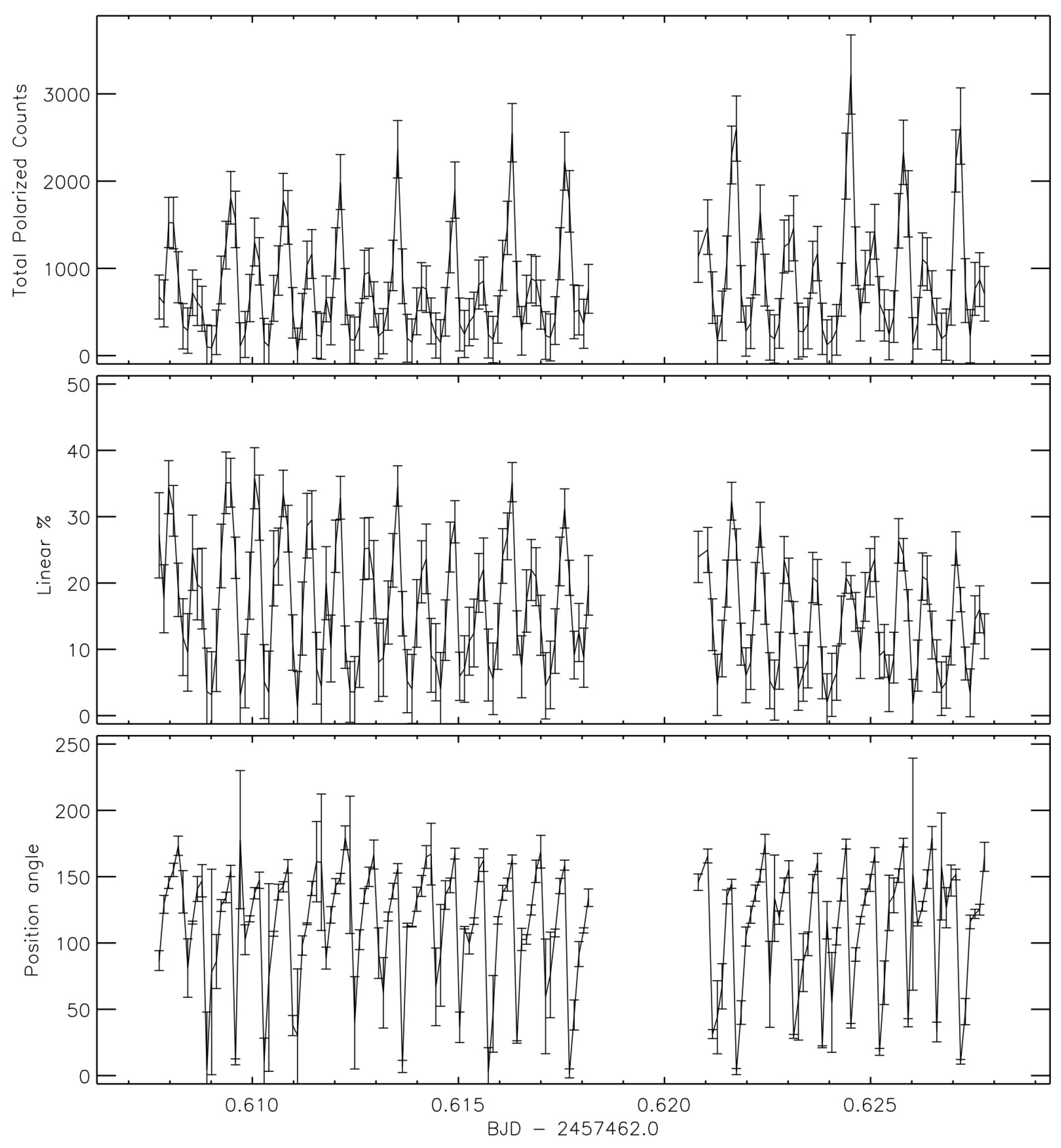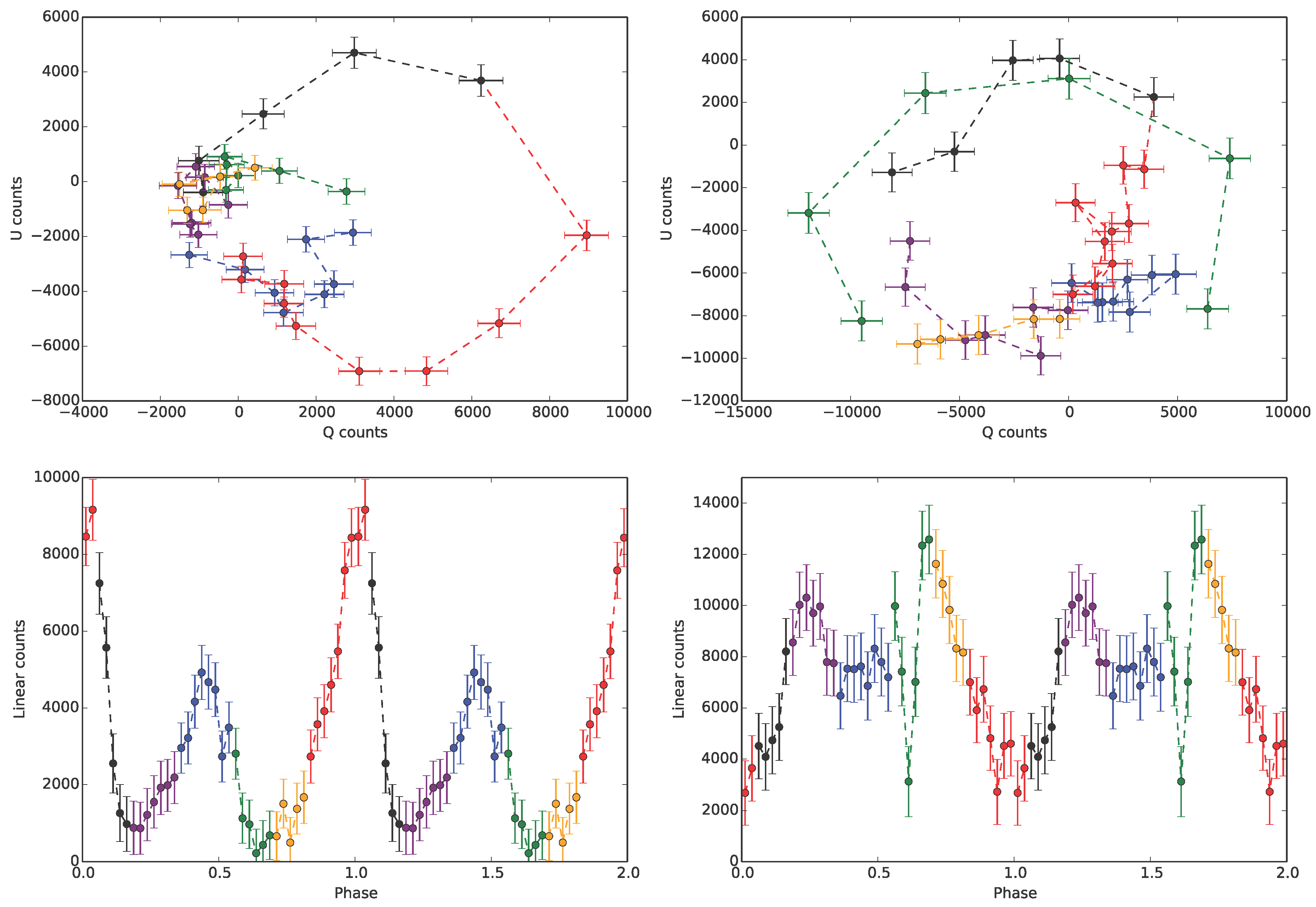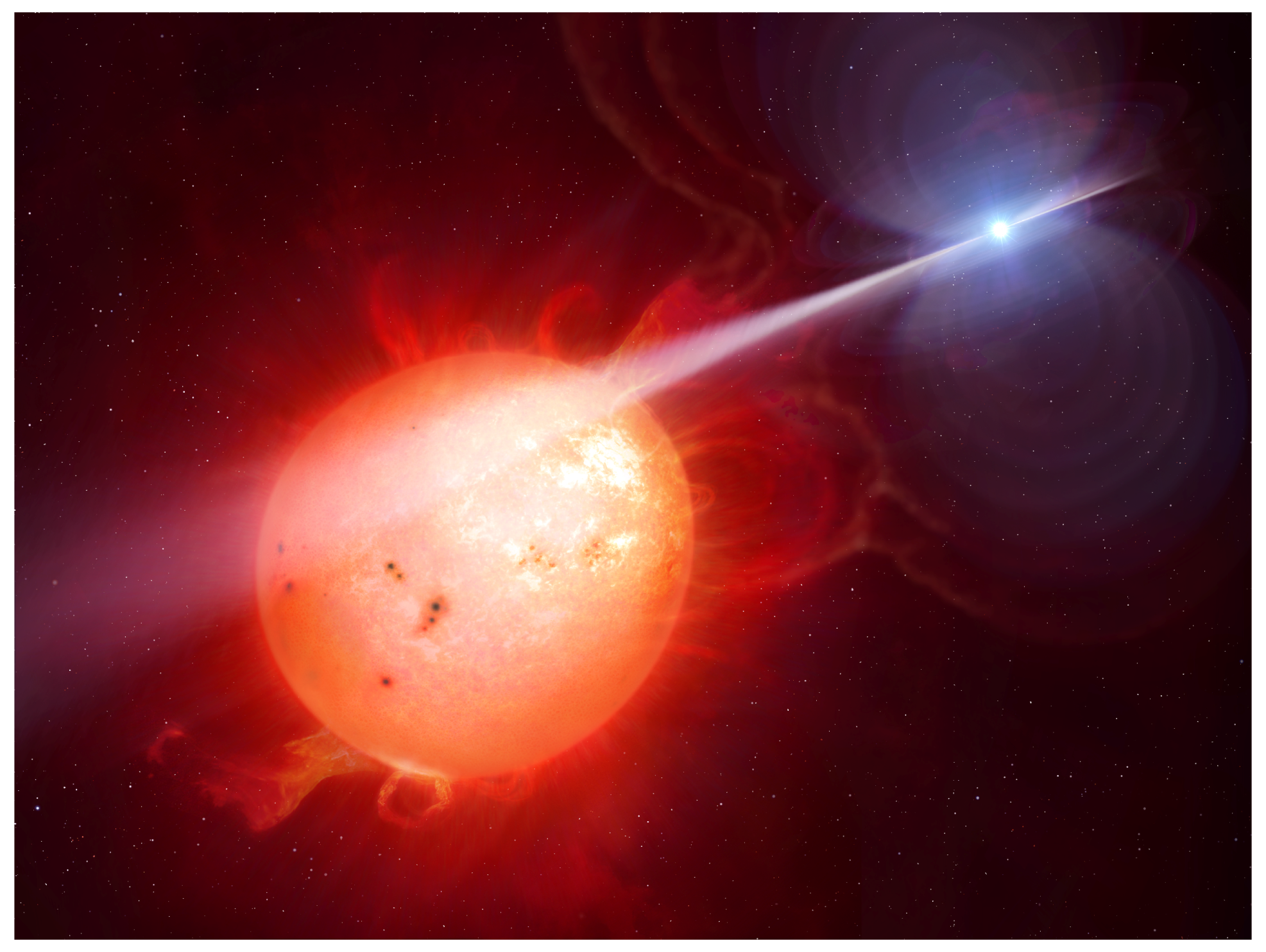1. Introduction
The close binary system AR Scorpii was recently discovered by Marsh et al. [
1] to consist of a fast rotating (~2 min) white dwarf in a 3.6 h orbit with an M5 red dwarf. Furthermore, the system appears to be spinning down at a rate of
4 × 10
s s
, which is the dominant source of the system’s luminosity. This extensive multi-wavelength study, from radio to X-ray wavelengths, showed that the system’s SED is dominated by pulsed non-thermal emission, predominantly at the 118 s beat period of the system. The low X-ray luminosity and lack of evidence for mass transfer (no flickering or broad emission lines) argues strongly against any accretion in the system, although the secondary star is clearly subjected to irradiation from the white dwarf, judging from the strong photometric orbital modulation coupled with the radial velocity motion of the narrow emission lines from the inner face of the secondary. These comprise both optical lines (Balmer and He I) and UV lines (Si IV and He II). The discovery by Buckley et al. [
2] that AR Sco is highly linearly polarized (up to 40%) and, more importantly, that the polarization is strongly modulated (up to 90% pulse fraction) on both the spin and beat periods, has strengthened the evidence that AR Sco behaves as a pulsar. The high level of polarization also led Buckley et al. [
2] to conclude that the white dwarf is highly magnetic, with a field strength as high as 500 MG. Various interpretations have been proposed to explain the observed properties, including direct MHD interactions between the magnetic fields of both components [
2], possibly producing bow shocks close to the surface of the M-star companion (e.g., [
3,
4]).
2. Luminosities
Marsh et al. [
1] determined the distance to AR Sco of 116 ± 16 pc from fitting an M5 star template to the observed spectrum and assuming the M-star companion was close to filling its Roche lobe. This led to the derivation of the individual luminosities of the M5 and white dwarf components, which in total is ∼4 ×
erg s
. This represents just ∼15% of the total system luminosity, dominated by the modulated non-thermal component, which varies from 0.6−3.6 ×
erg s
. The spin-down power of the system, derived from
, can be calculated from the formula
, where
I is the moment of inertia and
the spin frequency. The moment of intertia varies by over 5 orders of magnitude between a neutron star and a white dwarf, leading to spin-down powers of 1.1 ×
and 1.5 ×
erg s
, respectively. For the observed
, it is clear that the pulsed luminosity cannot be powered by a spinning down neutron star, since this falls short by about a factor of ∼2
in the required power. On the other hand, a spinning down white dwarf with the observed
is capable of explaining the total modulated power in the system.
In mass transferring white dwarf - red dwarf binaries (i.e., cataclysmic variables, or CVs), the dominant source of luminosity comes from accretion. The conclusion (e.g., [
1,
2]) that the white dwarf has a high magnetic field strength raised the possibility that AR Sco was an asynchronous magnetic CV, or intermediate polar, which are typically quite hard (
10–20 keV) and moderately luminous X-ray sources (∼10
–10
erg s
). In contrast, AR Sco has an X-ray luminosity of 5
erg s
(from a
observation [
1]), inconsistent with it being an intermediate polar. In addition, both the optical spectra and the photometric variations are different from that expected for a mass transferring binary (i.e., a CV). Spectral lines in such systems are typically much broader, often multi-component in nature, and are kinematically traced to accreting gas close to the white dwarf, or within its Roche lobe, like in an accretion disk. This is in contrast to the narrow emission lines seen in AR Sco that come from close to the L1 point of the illuminated secondary star [
1]. There is also the tell-tale absence of high frequency (>1 Hz) flickering associated with accretion in cataclysmic variables, in both magnetic and non-magnetic systems. Therefore the conclusion reached by [
1,
2] is that AR Sco is a detached binary, with no signs of accretion or mass loss through L1, powered predominantly by the spin-down of the magnetic white dwarf.
Finally, the observed low X-ray luminosity is added evidence that AR Sco cannot be a neutron star binary, i.e., a low mass X-ray binary (LMXB). At a distance of only 116 pc, this would make it the nearest and least X-ray luminous LMXB, with an observed ratio of only ∼0.04, quite atypical of LMXBs, whose ratios are typically ∼100.
3. Polarization Discovery and Behaviour
High speed photopolarimetry of AR Sco was undertaken on two consecutive nights (14 & 15 March 2016) using the
polarimeter on the SAAO 1.9-m telescope. This instrument ([
5]) enables all four Stokes parameters to be derived simultaneously, at a sampling rate as high a 10 Hz, using photomultplier tubes. The rapid photon-counting sampling mitigates atmospheric effects and allows data to be binned on any suitable timescale, to suit the desired time resolution or signal to noise. The observations shown here ([
2]) were binned such that the intensity (
I) is sampled at 1 s intervals, while the other Stokes parameters (
Q,
U &
V) were binned to 10 s.
In
Figure 1 we show the observations from the first night (14 March 2016), which show that the system was strongly linearly polarized, at levels reaching 40%, modulated predominantly on the harmonic of the spin and beat period, as determined from a period analysis [
2]. These two nights of observations covered differing orbital phase, namely
and
, respectively, which is the reason for differences in the phase-folded (on the 117 s spin period) polarization curves, as shown in
Figure 2 (bottom panels). These clearly show double-peaked polarized intensity variations, modulated with up to ∼90% pulse fraction (on 14 March). The linear polarization variations, plus the large swing in position angle (
), is a result of the viewing aspect, where the dipole is nearly perpendicular to the rotation axis of the white dwarf.
The difference between the curves on the two nights is a consequence of the different orbital phases of the two observations, which were at an average of 0.15 and 0.64, respectively. Both the spin and beat modulations combine differently on the two nights, resulting in the variability of the waveforms for the phase-folded observations. Subsequent observations, spanning many orbital cycles, have confirmed the stability of the orbital modulation and hence the amplitudes and phases of the side-band frequencies (work in progress).
In the top panel of
Figure 2 we show the spin phase averaged
Q and
U data, together with the trajectories of their motion in the
Q−U plane, which follow counter-clockwise loops, due to the changing magnetic field orientation. On the first night (
0.15), the main peak maps to the outer loop and the secondary peak maps to the small loop inside it. For the second night (
0.65), there is an apparent phase change and more complex polarized flux variations (see bottom panel), leading to a different trajectory in the
Q−U plane, indicative of changes in the combined white dwarf-red dwarf magnetic field topolgy with respect to our line of sight over the two nights.
The
Q and
U variations in AR Sco are qualitatively similar to that seen in the optical polarimetry of the Crab pulsar [
6], although for the Crab
p and
variations show somewhat different morphologies, with more abrupt
“swings”, possibly a consequence of the lower phase resolution of the AR Sco data. The polarized flux for the Crab shows a duty cycle of ∼30%, less that the minimum duty cycle estimated for AR Sco of ∼60%. For radio pulsars there are a range of different
swing morphologies observed [
7], which have been interpreted in terms of a rotating vector model, where the polarization vector (
p,
) is a projection on the sky of the direction of the magnetic field in the region where the polarized radiation is emitted.
4. Interpretation and Proposed Model
The strongly pulsed polarized emission in AR Sco is analogous to that observed in pulsars, like the Crab. The ratio of X-ray luminosity to spin-down power for AR Sco, , is , implying that most of the luminosity of the system is not produced by accretion of matter, but by spin-down energy loss, just as in a spin-down powered pulsar.
An upper limit on the magnetic dipole strength can be derived assuming that the bulk of the spin-down power is radiated by dipole radiation, which was shown by Buckley et al. [
2] to be ∼500 MG. Values this high have been derived for isolated magnetic white dwarfs, which is also within a factor of 2× of that seen in strongest magnetic cataclysmic variable (∼250 MG). An alternative model, assuming that a fraction of the spin-down power is dissipated through a magnetic stand-off shock near the secondary, has led to an estimate of the magnetic field of ∼100 MG [
4]. If rotational energy is also dissipated through magnetohydrodynamical (MHD) pumping of the secondary star, then a constraint can be placed by estimating the MHD power dissipated in the surface layers of the secondary [
8]. Dissipation will occur through magnetic reconnection and Ohmic heating, particularly in that part of the secondary star’s photosphere which faces the white dwarf. This could contribute to both the observed line emission and the strong orbital photometric modulation, which is at a maximum when the secondary star is at superior conjunction, when it is at the most favourable viewing aspect.
Due to the absence of conducting plasma from mass loss/accretion, it was shown [
2] that electric potentials of the order
can be induced over the distance between the white dwarf and the light cylinder, which has a radius of 6
cm, ∼10× the orbital separation of the two stars. This potential can accelerate electrons to energies of the order of
, resulting in pulsed and strongly polarized synchrotron emission, possibly up to to X-ray frequencies. The high level of linear polarization and its modulation is consistent with synchrotron emission of relativistic electrons in ordered magnetic fields [
2]. The periodic behaviour of the polarization, at both the white dwarf spin and the beat periods, is also consistent with the emission being produced by the interaction of the white dwarf’s magnetosphere with the M-dwarf, which explains the beat period as a consequence of orbital modulation.
The spectral energy distribution (SED) in AR Sco [
1,
4]) shows a
(
) self-absorbed power law spectral distribution for
, i.e., at infrared to radio wavelengths. We have suggested [
2] that these originate from pumped coronal loops of the nearly Roche lobe-filling secondary star. The magnetic flux tubes of the secondary star are periodically distorted by the fast rotating white dwarf magnetic field, inducing strong field-aligned potentials and synchrotron flares, consistent with the observed power law at
and the peak emission at
. The emission is therefore expected to be pulsed at the beat frequency, consistent with the ATCA observations at 5.5 and 9.0 GHz [
1].
At higher frequencies,
(optical-UV-X-rays), the SED follows a different
power law [
1], where
(see also [
3]). This component is produced by non-thermal synchrotron emission from accelerated charged particles as the magnetic white dwarf dipole interacts with the M-star magnetic field and wind, and can explain the high level of linear polarization observed at optical frequncies.
5. Discussion
The high degree of asynchronism in AR Sco (
) implies that the white dwarf was spun up, presumably as a result of a previous phase of mass transfer. Another system, AE Aqr, which also harbours a fast spinning (
= 33 s) white dwarf which is spinning down [
9], was shown [
10,
11] to have experienced a previous high mass transfer phase. In this case the secondary star may have shed its outer envelope in a catastrophic run-away mass transfer process, resulting in the white dwarf being spun-up. However, in the case of AR Sco, there is currently no observational evidence to indicate that it has evolved through such an extreme high mass transfer phase. Therefore the evolutionary path which AR Sco has followed is still somewhat of an open question.
The high magnetic field of the white dwarf in AR Sco also presents a significant problem when it comes to spinning up the white dwarf in the first place, since material will tend to be ejected rather than accreted, except at very high accretion rates. This is precisely what the current situation is for AE Aqr, which is acting as a propellor, ejecting rather than accreting material from its companion [
9]. Since the observed white dwarf spin-down timescale for AR Sco of ∼10
years [
1,
2] is less than the spin-orbit synchronization timescale of ∼2.5 × 10
years, calculated for MHD torques alone [
2], this implies that most of the spin-down power is dissipated through other channels. The high value of the magnetic field is therefore the reason for the current large spin down rate, through the various mechanisms (e.g., dipole radiation, MHD interactions) which rob the white dwarf of its angular momentum.
AR Sco is a unique object and the best candidate for a white dwarf pulsar—notwithstanding the one crucial point that it is not a neutron star—based on the following attributes:
Spin-down powered
SED dominated by synchrotron emission
Strongly linearly polarized
Spin modulated magnetic dipole
Pulsations are seen from the radio to the ultraviolet (and more recently in X-rays)
Beamed radiation from relativistic electrons accelerated in a stong electrical potential
Lorentz factors of
We show an artist’s impression of AR Sco in In
Figure 3.
Further observations, particularly at UV, X-ray and radio wavelengths, will be important in determining the exact nature of the emission mechanisms operating in AR Sco. More extensive time resolved polarimetry, obtained at SAAO during the 2016 and 2017 observing seasons, will also help to constrain the polarized emission models by disentangling the two closely spaced polarized signals, at the spin and beat period, leading to more definitive conclusions regarding geometry. Its proximity in the outskirts of the Ophiuchus molecular cloud also raises the interesting prospects that the system could be a source of EHE -ray emission through charged particle interactions.







